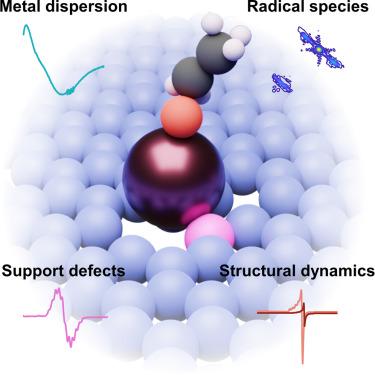当前位置:
X-MOL 学术
›
Chem Catal.
›
论文详情
Our official English website, www.x-mol.net, welcomes your
feedback! (Note: you will need to create a separate account there.)
Electron paramagnetic resonance spectroscopy for the analysis of single-atom catalysts
Chem Catalysis ( IF 11.5 ) Pub Date : 2024-10-15 , DOI: 10.1016/j.checat.2024.101136 Mikhail Agrachev, Vera Giulimondi, Ivan Surin, Sharon Mitchell, Gunnar Jeschke, Javier Pérez-Ramírez
Chem Catalysis ( IF 11.5 ) Pub Date : 2024-10-15 , DOI: 10.1016/j.checat.2024.101136 Mikhail Agrachev, Vera Giulimondi, Ivan Surin, Sharon Mitchell, Gunnar Jeschke, Javier Pérez-Ramírez

|
Single-atom catalysts (SACs) are an important material class, lying at the forefront of precision design for heterogeneous catalysis research. Despite extensive investigations of their structure and reactivity using state-of-the-art analytical tools, new approaches are sought to improve the understanding of their properties and catalytic behavior. This review highlights the often-overlooked potential of electron paramagnetic resonance (EPR) spectroscopy, which is exceptionally suited to studying isolated paramagnetic species. EPR provides valuable complementary insights into SACs, including metal oxidation state, dispersion degree, local coordination environment, and catalytically relevant features of support materials. To enhance the technique’s accessibility, we provide a tutorial on EPR, summarize significant findings to date, place them within a broader methodological framework for SAC applications, and identify key directions for future research.
中文翻译:

用于分析单原子催化剂的电子顺磁共振波谱
单原子催化剂 (SAC) 是一类重要的材料,位于多相催化研究精密设计的前沿。尽管使用最先进的分析工具对其结构和反应性进行了广泛的研究,但人们仍在寻求新的方法来提高对其特性和催化行为的理解。这篇综述强调了电子顺磁共振 (EPR) 波谱经常被忽视的潜力,它特别适合研究孤立的顺磁性物质。EPR 为 SAC 提供了有价值的补充见解,包括金属氧化态、分散度、局部配位环境和支持材料的催化相关特征。为了提高该技术的可及性,我们提供了有关 EPR 的教程,总结了迄今为止的重要发现,将它们置于 SAC 应用的更广泛的方法框架中,并确定了未来研究的关键方向。
更新日期:2024-10-15
中文翻译:

用于分析单原子催化剂的电子顺磁共振波谱
单原子催化剂 (SAC) 是一类重要的材料,位于多相催化研究精密设计的前沿。尽管使用最先进的分析工具对其结构和反应性进行了广泛的研究,但人们仍在寻求新的方法来提高对其特性和催化行为的理解。这篇综述强调了电子顺磁共振 (EPR) 波谱经常被忽视的潜力,它特别适合研究孤立的顺磁性物质。EPR 为 SAC 提供了有价值的补充见解,包括金属氧化态、分散度、局部配位环境和支持材料的催化相关特征。为了提高该技术的可及性,我们提供了有关 EPR 的教程,总结了迄今为止的重要发现,将它们置于 SAC 应用的更广泛的方法框架中,并确定了未来研究的关键方向。






























 京公网安备 11010802027423号
京公网安备 11010802027423号